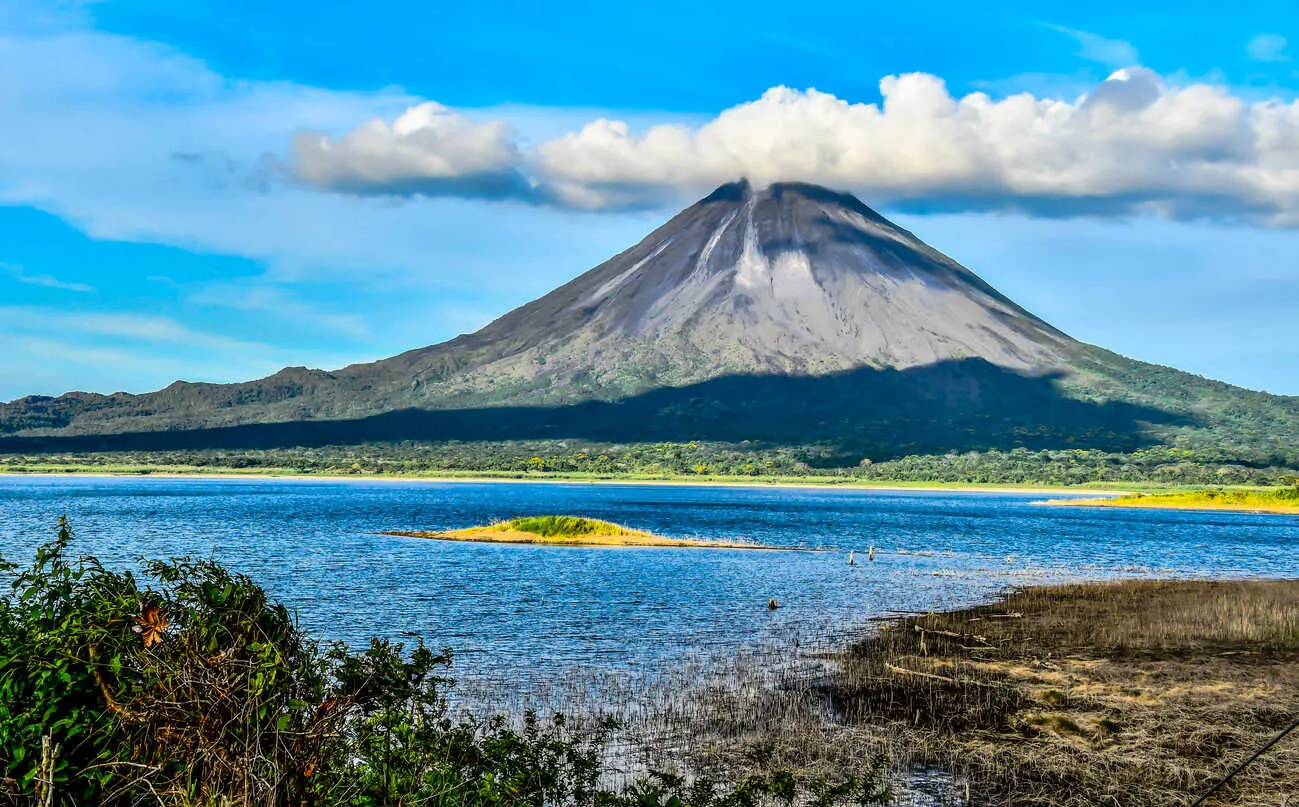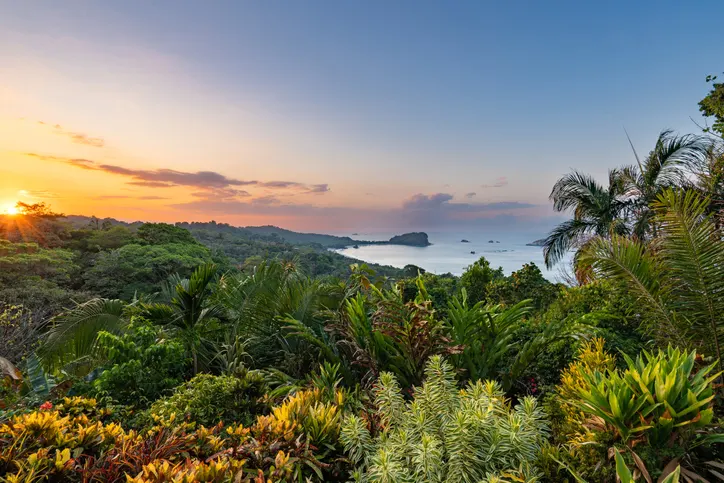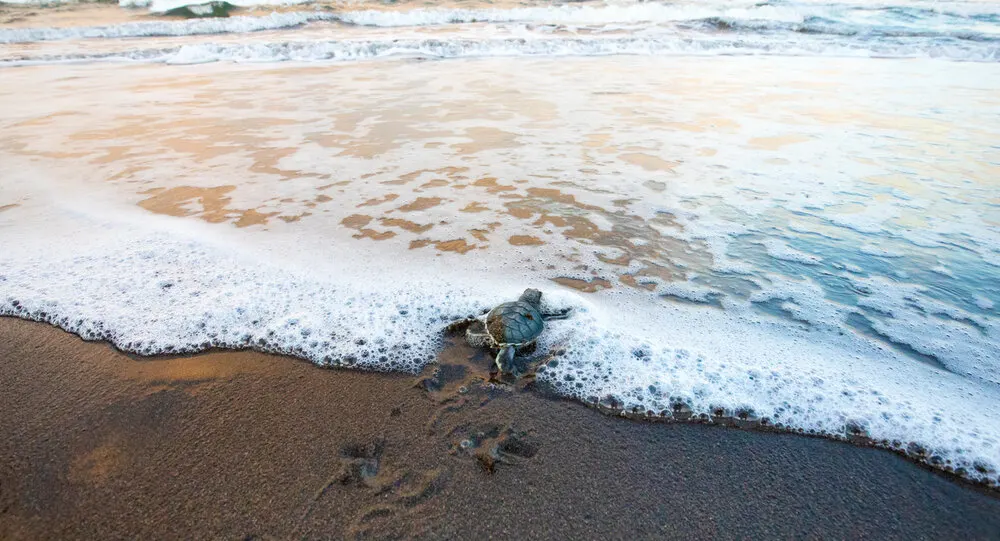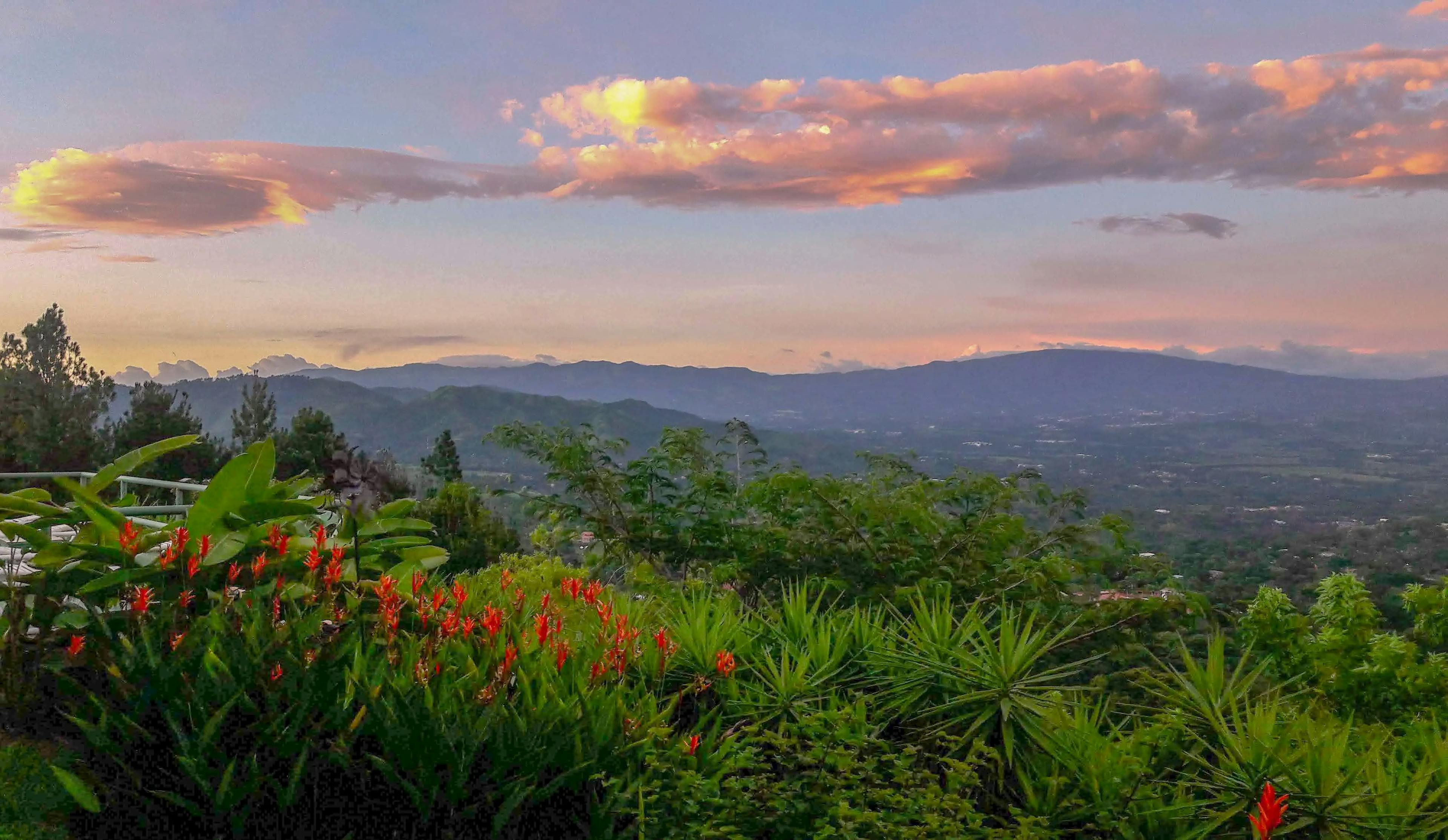When you travel in Costa Rica, you’ll know you’ve found paradise, and so have an incredible variety of plants and animals. In fact, even though Costa Rica is only about the size of West Virginia (only 0.03% of the world’s landmass), about 5% of the known species of plants and animals in the world can be found there. It’s due in part to its many micro-climates. There’s the tropical Pacific coast, the slightly cooler Caribbean coast, the year-round temperate Central Valley, the plateau regions, and forest-covered mountains. Luckily, the government and private landowners have recognized the unique nature of Costa Rica, designating nearly 25% of the land in the country as national parks or private reserves.
Costa Rica experiences a rainy season from May to November, with sunny mornings followed by afternoon showers and clear evenings. September and October tend to be the wettest months, with prolonged rainfall in some regions. The dry season runs from December to April, typically bringing little to no rain.
Thanks to its rich geography, Costa Rica is a pioneer in ecotourism, offering activities like surfing, snorkeling, deep-sea fishing, cycling, ziplining, and spelunking.
If urban life is more your scene, Costa Rica’s big cities, especially San José, the capital, and its suburbs, have all the fun and culture you’d expect in a modern city, from theaters, art galleries, and national and international performers to excellent shopping and dining to exciting and varied nightlife.
Get Your Free Costa Rica Report Here
Get Your Free Costa Rica Report Here
Learn more about Costa Rica and other countries in our daily postcard e-letter. Simply enter your email address below and we’ll send you a FREE REPORT - Explore the Old World in Laidback Costa Rica.

By submitting your email address, you will receive a free subscription to IL Postcards and special offers from International Living and our affiliates. You can unsubscribe at any time, and we encourage you to read more about our Privacy Policy.
Activities for the Adventurous Costa Rica Traveler
Cycling & Hiking: Costa Rica has a number of bike and hiking trails that crisscross the country. Whether you're into slow treks, leisurely cycling, or rugged biking, the country's trails will treat you to breathtaking sights that include rivers, volcanoes, plantations, waterfalls, hot springs, and more.
Surfing: It was this sport that first put Costa Rica on the map for adventure travelers. You’ll find consistently good waves all up and down the Pacific coast, with a few good spots on the Caribbean, too. There are expert level waves but also good areas for beginners. Surf schools are in just about every seaside town popular with visitors.
Sport Fishing: Ready for a Hemingway-style battle with a swordfish or marlin? You can get it on Costa Rica’s Pacific coast, which is a mecca for fishermen. Several marinas (Quepos, Golfito, and Playa Herradura, among others) provide the perfect home base for offshore adventures to catch billfish, tuna, mahi mahi, snapper, and more.
Horseback Riding: Horseback riding is a favorite tourism pastime in Costa Rica, giving you easy access to some of the country's most stunning natural beauty. Both day and overnight trips are available in several regions of the country, depending on whether you feel like a beach, mountain, or forest ride.
One tour takes you from the town of La Fortuna to the Fortuna waterfalls in the rainforest overlooking the town. You'll get a wonderful view of Arenal Volcano, leave the horses on a hill, and descend on foot along a forest path to the falls plummeting 200 feet into a deep pool, where you can take a cool dip.
Canopy Tours: One of the most popular activities in Costa Rica is the cloud forest canopy tour, also known as ziplining. You can take a traditional ride, the kind you’ve seen on TV where you’re strapped in a harness and zoom along a cable at high speed from one treetop platform to the next, or you can try the aerial gondola rides, which are much slower and allow you to sit comfortably. Either way, keep your eyes peeled for forest wildlife, which you’ll be able to see in their natural habitat. There’s been a proliferation of canopy tour companies in the country, so be sure to choose a well-established one with good safety practices. Some of the best canopy tours in the country can be found in the Lake Arenal region and the Monteverde Cloud Forest.
Tourism in San Jose
Located in the country's central valley, the nation's capital and surrounding suburbs are home to just over a million people. There's plenty to do in this thriving modern city. You can see what's happening at the University of Costa Rica, take in the architectural beauty of the National Theatre, or museum-hop among the Gold, Jade, Costa Rican Art, National, and other art and natural history museums. Enjoy the fine dining, and stick around for the city's exciting nightlife.
Shopping is more like treasure-hunting at the Central Market, a busy open-air market where you'll find fresh produce and unique local crafts. The city's shops feature all your favorite amenities and brands.
The Melía Cariari Golf Course, a designer championship course at the Melía Cariari Hotel, offers exceptional golfing and hosts pro and amateur events regularly.
Costa Rica’s Most Spectacular Parks
One of the quickest ways to fall in love with Costa Rica is to visit a national park. That’s easy to do, since there are 161 parks and wildlife refuges, each one an example of the country’s commitment to preserving its natural beauty. In fact, Costa Rica has more parks and wildlife refuges than any other country of a similar size.
By visiting a national park, you can watch exotic birds and rare monkeys, see some of the world’s most beautiful orchids, and experience such wonders as volcanoes, hot springs, cloud forests, waterfalls, mangroves, and coral reefs. The parks offer a glimpse into an exotic natural world, and they also provide opportunities for hiking, swimming, diving, fishing, surfing, and enjoying breathtaking rides on aerial trams.
Many of the parks also have bargain-rate hotels or B&B-like facilities where you can stay overnight. Tours are inexpensive and can be easily arranged by park administrators, hotels, or commercial tour groups. Most of Costa Rica’s national parks can be reached by car, and they’re also served by the country’s domestic airlines. The entrance fee ranges from $10 to $20 (residents typically receive a substantial discount), and children under 12 are admitted free. Some parks are closed for one day each week, usually Monday.
Here are some of Costa Rica’s most spectacular parks:
Arenal Volcano National Park

The site of a 5,479-foot cone volcano, Arenal Volcano National Park is northwest of San José, about halfway between Costa Rica’s Caribbean and Pacific shores. You can get great views of the volcano from many of the hotels and lodges in the park, or you can go on guided tours that take you closer to the mountain of fire. Back in 1968, the Arenal Volcano erupted, killing dozens of people as it spewed gasses and fiery boulders on nearby villages. Today, you can visit the volcano and watch safely as the Earth emits smoke into the air.
Because clouds often hang over the area, the best time to view the volcano is just before dawn on a moonlit night. By then, the clouds are almost sure to have moved out, making it easy to see.
Arenal Volcano National Park is also a place to spot some of the most beautiful birds on the planet, many of which will be new to visitors from the U.S., Canada, or Europe. When you’re not gazing up at the falcons and kestrels, you can watch the Passerini’s Tanager, whose red feathers almost seem to glow. Or you can listen to the yellow-throated Euphonia—a small, beautiful bird with a repertoire of songs so varied that ornithologists themselves are often confounded. The Euphonia shares the same habitat with the white-necked Jacóbin. No, it isn’t an unsuccessful French revolutionary, as the name might imply, but an exotic hummingbird that is easy to spot at Arenal.
The government agency that operates Arenal Volcano National Park is Area de Conservación Arenal Tempisque, Tilarán, Guanacaste; tel. +506 2695-5180; email: ACATGrupo@sinac.go.cr.
Manuel Antonio National Park

The Central Pacific Coast is booming with activity, but in the midst of it all there’s an oasis of calm and beauty—the National Park at Manuel Antonio.
Less than three hours by car from San José, Manuel Antonio National Park is a place where you can rent a small boat or take leisurely hikes in an area where the rainforest meets the ocean. If you want to picnic, there are plenty of tables near the beach and even freshwater showers. Hotels can arrange for snorkeling and scuba excursions. It’s hardly a surprise that it is the most visited park in the country.
Inside the park or close to it are opportunities for canopy tours, fishing, mountain biking, river rafting, horseback riding, bird watching, surfing, sailing, golfing, and jet skiing.
When you hike in the park, don’t be startled if monkeys scream at you from high in the trees or even throw something down at you. You’ll see rare squirrel monkeys, white-faced capuchins, and mantled howlers. But don’t be distracted by the primates—there are also sloths, coatimundis, and agoutis. Sharing the trees with the monkeys are dozens of bird species, including toucans and woodcreepers. Along the shore, it’s fun to watch the pelicans and kingfishers.
For more information on the park, visit the website www.manuelantoniopark.com.
Palo Verde National Park

You’ll turn your eyes skyward as the graceful jabiru circles overhead before landing beside its nest in a low tree. When it lands, you immediately realize just how large the bird is—nearly 5 feet tall, with a wingspan of about 9 feet! It’s the world’s largest stork, and the Palo Verde National Park is one of the few places where you can watch the black-and-white Jabirus in their own home.
The park is also home to crocodiles, peccaries, monkeys, coatimundis, white- tailed deer, and some 300 species of birds, including anhingas, great curassows, night herons, roseate spoonbills, scarlet macaws, white ibises, and wood storks.
With more than 45,000 acres of marshland, Palo Verde National Park is just north of the Gulf of Nicoya on Costa Rica’s North Pacific Coast. You can reach the park by driving north from San José to the village of Bagaces in Guanacaste. From there, a 17-mile-long dirt road leads to the park. The area is one of the driest and hottest in Costa Rica, and animals are attracted to Palo Verde because the Tempisque River flows through on its way to the nearby Gulf of Nicoya.
The park is operated by Area de Conservación Tempisque, tel. +506 2522- 6500; website: www.sinac.go.cr/ES/ac/ act/Paginas/default.aspx.
Tortuguero National Park

The name of the park is Spanish for “turtle catcher,” and in this case, Tortuguero refers to the people who once made a living by catching the many types of turtles that live along Costa Rica’s Caribbean Coast. Today, turtles are protected, and the “catchers” are visitors to the park who catch sight of the magnificent animals as they come and go on the beach.
The park is a favorite nesting ground for hawksbills, loggerheads, and Pacific green turtles, which come ashore from midsummer through mid-autumn. From February to July, the largest of all living turtles, the leatherback, nests at Tortuguero. Its size amazes many visitors—an adult leatherback is nearly 9 feet long and can weigh up to 1 ton!
Tortuguero is one of the few national parks that can be reached only by boat or plane. Hotels and travel agencies can arrange for travel by boats that leave from several villages close to Puerto Limón, just south of Tortuguero. Regional airlines provide regular service. The airstrip in Tortuguero is at the northern tip of a narrow island, which stretches along the coast much like the beaches that parallel Florida’s Atlantic Coast. South of the airstrips are Tortuguero’s hotels and restaurants.
Inland from the beach are swamps, woodlands, and eventually rainforests, all home to dozens of exotic bird species and mammals that include the rare West Indian manatee and howler and capuchin monkeys. Except for the beach itself, the park is best seen by boat. Hotels can make arrangements for boat tours, or you can go on your own in rented canoes or kayaks. Visitors are permitted to walk along the beach during the day, but after 6 p.m. the coast belongs to the turtles.
The government agency that oversees the parks, Sistema Nacional de Areas de Conservación (SINAC), has an increasing amount of useful information on its website, www.sinac.go.cr, including fun 360-degree photos of some parks.
This site is also helpful:
Costa Rica Tourism and Travel Bureau, website: www.costaricabureau.com/nationalparkslist.htm.
Get Your Free Costa Rica Report Here
Get Your Free Costa Rica Report Here
Learn more about Costa Rica and other countries in our daily postcard e-letter. Simply enter your email address below and we’ll send you a FREE REPORT - Explore the Old World in Laidback Costa Rica.

By submitting your email address, you will receive a free subscription to IL Postcards and special offers from International Living and our affiliates. You can unsubscribe at any time, and we encourage you to read more about our Privacy Policy.














